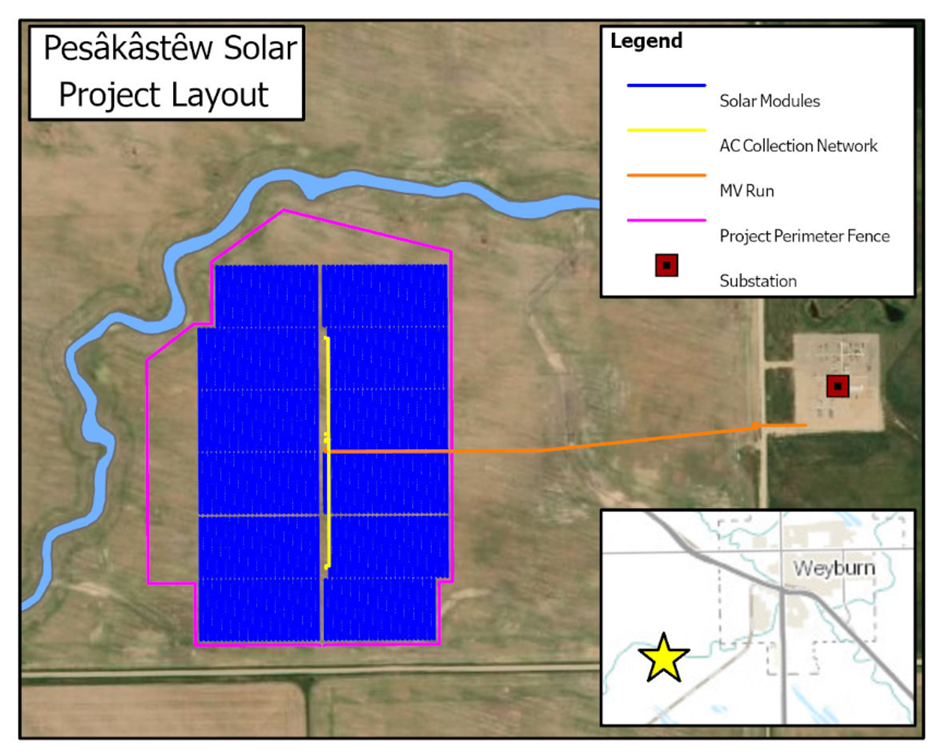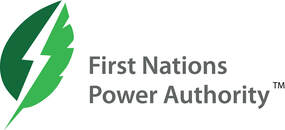Welcome to the official Pesâkâstêw Solar Project webpage!
This webpage has been created to provide information about the project to the community, stakeholders, and the First Nations of Saskatchewan.
About the project
|
The Pesâkâstêw Solar Project is a 10 MW solar farm in the Rural Municipality of Weyburn, Saskatchewan, approximately 4 km southwest of the city of Weyburn. The project is set to be operational by summer 2022, supplying clean energy to the Saskatchewan electrical grid.
This project is approximately 110 acres (44.5ha) of land and will connect directly to the SaskPower substation adjacent to the site. The project will be able to provide electricity to approximately 2,500 homes annually. With the best solar resource in Canada, Saskatchewan is well-positioned for solar projects to make significant contributions to achieving the 50% renewable electricity by 2030 target set by the province. In particular, the Rural Municipality of Weyburn, being located in the south, has some of the highest solar potential in the province. |
What's happening?
Public Consultation |
The Open House held on March 6, 2019 was attended by more than 30 community members. Plans for a second Open House have been deferred due to COVID-19 restrictions. Any future events will be advertised here and through local media outlets. |
Geotechnical Investigations |
Geotechnical investigative studies have been conducted on site, which revealed more about the soil conditions on site. This work is helping to shape the design of the project, and to select the materials and technologies that will be used to ensure compatibility with the conditions. |
Environmental Surveys |
Environmental surveys, including those for wildlife, vegetation, and visual impacts, were conducted in order to assess the potential impact this project may have on the local and regional environment. |
Municipal Permitting |
Natural Forces applied to the Rural Municipality of Weyburn for a Development Permit according to their bylaw on solar developments. A public hearing was held virtually in June 2020 by the RM of Weyburn. Following the Public Hearing, the Development Permit was issued for the project. |
Technical Proposal |
A technical proposal was submitted to the Ministry of Environment on June 8th, 2020. The Technical Proposal describes the proposed project and engagement activities, and assesses potential environmental impacts. See the Environmental Studies section below to read the Technical Proposal. The Technical Proposal was reviewed by the Ministry of Environment. The Ministry of Environment has set conditions on the Project, however the project is able to proceed as long as it follows the commitments made in the Technical Proposal and all other relevant permits are obtained. |
Construction Update
Natural Forces is pleased to report that construction activities are nearly complete - he panels have been installed, and we predict commissioning to take place summer 2022.
For photos of the project throughout construction, please see the gallery below!
For photos of the project throughout construction, please see the gallery below!
Project Proponents
The project is being developed by Natural Forces on behalf of Pesâkâstêw Solar Limited Partnership who owns the Pesâkâstêw Solar Project. The Pesâkâstêw Solar Limited Partnership is a partnership between George Gordon Developments Ltd., Red Dog Holdings Ltd. and Natural Forces.
|
George Gordon Developments Ltd. (GGDL) is the economic development branch of George Gordon First Nation. By establishing important business partnerships, GGDL has become a regional First Nation leader in business development. Through these partnerships, GGDL has assembled the capacity and capability to successfully enter high quality bids on major projects related to resource development with renowned North American companies.
Red Dog Holdings Ltd. (RDHL) is the economic development branch of Star Blanket Cree Nation. One of the main goals of RDHL is to develop long term partnerships with companies that have shared values and objectives. RDHL also strives to provide opportunities for sustainable employment, training, wealth creation, and community development. Natural Forces is a private independent power producer that delivers renewable energy projects in partnership with local communities across Canada. We develop, construct, own, and operate wind, solar, and hydro projects with First Nation communities, universities, municipalities, and local community funds. |
The Pesâkâstêw Solar Limited Partnership came to fruition through the First Nations Power Authority (FNPA). As all three entities were members of the FNPA, the organization facilitated introductions between George Gordon First Nation, Star Blanket Cree Nation, and Natural Forces. Over the course of many months, George Gordon Development, Red Dog Holdings, and Natural Forces formed the partnership to develop renewable energy projects together. The first opportunity for this partnership arose through the FNPA’s Opportunity Assessment for a 10 MW Solar Project.
Public Consultation
The first public open house for the Pesâkâstêw Solar Project was held on March 6th, 2019 at the Captain's Hall (122 4th St.) in Weyburn. This was a free-form open house at which we had display boards with information about the project and representatives of the Pesâkâstêw Solar Limited Partnership circulating to answer any questions. The open house was well attended, with more than 30 community members participating. Overall, the feedback we received at the event was positive. All of the questions from the session have been answered and added to the Frequently Asked Questions section of this website (below). The feedback and suggestions we received will be applied to future public houses and the project itself. All comments will serve to shape our actions and decisions as we move forward. The informational handout that was available at the open house and a document summarizing the open house with all of the questions and responses are available here:
|
| ||||||||||||
We hope that community interest and involvement continues as the project progresses.
The Overall Process
There are three main phases to advance a solar project from a mere idea to actually producing energy, which are Development, Construction, and Operation. Thereafter, Decommissioning is the fourth phase that returns the site to its condition before the project was constructed. Each phase involves many steps and milestones to achieve in order to follow through prior to starting the subsequent phase of the project.
1 - Development
3 - Operation
|
2 - Construction - Current Phase
4 - Decommissioning
|
Environmental Studies
|
|
According to the Saskatchewan Environmental Assessment Act, 2018, a solar project of this size will require to submit a Technical Proposal to the province. This Proposal, which was submitted to the Saskatchewan Environmental Assessment and Stewardship Branch in May 2020, included comprehensive studies which were conducted on site, including:
A copy of the Technical Proposal is provided below.
| |||||||
Photo Gallery
More pictures will be added here as the project progresses.
Frequently Asked Questions
Questions that are asked by community members will be posted and answered in this section. This section will be updated continually throughout the life of the project.
Will there be a maintenance plan for the project? If so, what will it include?
Yes, there will be a maintenance plan, which will be part of the operations plan. Generally, equipment maintenance will be driven by the results of regular on-site inspections of the equipment, including solar panels, electrical connections, inverters, and transformers. Based on these inspections, repairs and maintenance will be carried out as needed.
Land inspections will also be part of the maintenance plan, conducted to monitor site drainage, monitor erosion, and assess risk of grass fires. Land repairs and maintenance will be driven by the results of land inspections. Cleaning the solar panels is not planned at this time, however the first year of operation will assist in determining if cleaning should be considered as part of the regular maintenance. Snow removal is dependent upon final design.
How will the site be re-vegetated after construction?
There will be a vegetation management plan as part of the operations plan. Vegetation management is expected to evolve over the life of the project. The plan includes planting a ground cover underneath the panels after construction is complete. The ground cover will be selected with a view to minimizing maintenance while considering shading and moisture availability under the panels, weed removal requirements, native species, and short-growing species.
How will the site be reclaimed after the project is decommissioned?
At the end of the project life, the site will be de-energized and all of the equipment will be dismantled and removed. This will include all surface components as well as those subsurface components to a depth of 1 m. Equipment and materials will be recycled as appropriate. The soil and land will be restored to original grade. In consultation with the municipality and landowner, seeding will be carried out growing to prevent topsoil erosion.
How much property tax will this project supply for the RM of Weyburn?
At this time, the property tax assessment indicates that the project will pay approximately $28,000 to $47,000 per year in property taxes. As property taxes are a function of the cost of specific equipment items and structures, the value of taxes paid will decrease as the value of the project depreciates.
Will the project produce a lot of noise during operation?
Solar projects emit very little noise, with the loudest noise being from the transformers. As the project is located directly adjacent to an existing SaskPower owned substation, the background noise levels will far exceed the noise from the project. As such, the project is not expected to create significant increase to the noise levels.
How big is each solar panel/module?
The average size of solar module used in a utility sized solar project is approximately 1 m x 2 m. Together, several solar modules form a solar array. While this will likely be the size of modules used for this project, the design of the project and the specific equipment have not been finalized.
When will the project start producing electricity?
The project is planned to be commissioned in late 2021, which will mark the beginning for electricity production on the site.
Do solar panels produce glare? How will this impact nearby houses, traffic, and animals?
Solar panels can produce some glare, but no more than what might be produced from a still pond. This project is expected to have negligible, if any, glare impact in the surrounding area.
How does the Environmental Assessment process work?
According to the Saskatchewan Environmental Assessment Act, 2018, a solar project of this size is required to submit a Technical Proposal (expanded upon below) to the Saskatchewan Environmental Assessment and Stewardship Branch (EAB). This is the first step in the Environmental Assessment (EA) process. The Technical Proposal is then screened by the staff at the Department of Environment to determine if the project is deemed to be a Development under the definition in the Act. A Development is a project deemed to have an effect on unique, rare, or endangered features in the area, use a substantial provincial resource, cause emissions or by-products, cause widespread concern due to potential environmental changes, induce significant environmental change, or have a significant impact on the environment.
If it is determined that the project is not a Development, the project can proceed, however it is still required to secure a number of additional applicable permits and approvals under other departments and government levels.
If it is determined that the project is considered a Development, the proponent is required to conduct an EA and submit an Environmental Impact Statement (EIS). This document is reviewed by the Saskatchewan EA Review Panel and the EAB, which, if necessary, provide comments for revisions to the proponent. Once the EIS is deemed adequate, it is released for a 30-day public review period along with the technical review comments. Finally, the EIS, technical review comments, and any public comments are submitted to the Minister who decides whether or not to approve the development. A flow chart of this process can be found here.
What goes into a Technical Proposal?
The Technical Proposal that must be submitted to the Saskatchewan Environmental Assessment and Stewardship Branch requires the following information:
Who makes the decision of whether the project can proceed or not?
If the project is not deemed a Development, the staff at the Saskatchewan Environmental Assessment and Stewardship Branch decide if the project requires additional permits.
If the project is deemed a Development and be required to submit an EIS, the Minister of Environment makes the final decision at the end of the Environmental Assessment process as to whether the project can proceed or not. The Minister is given all of the technical review comments and the public comments to aid in this decision.
When do the environmental studies occur?
Environmental studies are typically conducted from early Spring through Fall. During the 2018 study season, the following studies were completed:
The field surveys conducted during the 2019 season include:
Are there any environmental sensitivities near the proposed site?
Based on the data gathered to date, the environmental sensitivity of the site has been designated as low. Some drainage channels have been observed, but it is believed that this will be advantageous to the project in helping to maintain natural drainage on the site during operation.
Who are the proponents and where are they from?
There are three proponents for this project who, together, form the Pesâkâstêw Solar Limited Partnership. The limited partners are:
How does the partnership between First Nations and the independent power producer work?
The Pesâkâstêw Solar Limited Partnership is a true equity partnership between Natural Forces, and George Gordon Developments Ltd. and Red Dog Holdings Ltd. Each partner contributes their proportionate share of the capital required for this project and once the project is operational, each partner will receive their proportionate share of project income.
How are Atim-Ka Mikosit - ONEC and WSP involved in the project?
Atim-Ka Mikosit - ONEC are acting in their capacity as the project engineers for the design and construction of the project.
WSP have been hired to conduct the environmental baseline surveys on the project site.
Have you considered the use of local sheep for vegetation control in the project area instead of mowing?
Yes, sheep are being considered for vegetation control around the project area. There are several methods of controlling the vegetation being considered. Vegetation control will be part of the vegetation management plan.
Will there be a maintenance plan for the project? If so, what will it include?
Yes, there will be a maintenance plan, which will be part of the operations plan. Generally, equipment maintenance will be driven by the results of regular on-site inspections of the equipment, including solar panels, electrical connections, inverters, and transformers. Based on these inspections, repairs and maintenance will be carried out as needed.
Land inspections will also be part of the maintenance plan, conducted to monitor site drainage, monitor erosion, and assess risk of grass fires. Land repairs and maintenance will be driven by the results of land inspections. Cleaning the solar panels is not planned at this time, however the first year of operation will assist in determining if cleaning should be considered as part of the regular maintenance. Snow removal is dependent upon final design.
How will the site be re-vegetated after construction?
There will be a vegetation management plan as part of the operations plan. Vegetation management is expected to evolve over the life of the project. The plan includes planting a ground cover underneath the panels after construction is complete. The ground cover will be selected with a view to minimizing maintenance while considering shading and moisture availability under the panels, weed removal requirements, native species, and short-growing species.
How will the site be reclaimed after the project is decommissioned?
At the end of the project life, the site will be de-energized and all of the equipment will be dismantled and removed. This will include all surface components as well as those subsurface components to a depth of 1 m. Equipment and materials will be recycled as appropriate. The soil and land will be restored to original grade. In consultation with the municipality and landowner, seeding will be carried out growing to prevent topsoil erosion.
How much property tax will this project supply for the RM of Weyburn?
At this time, the property tax assessment indicates that the project will pay approximately $28,000 to $47,000 per year in property taxes. As property taxes are a function of the cost of specific equipment items and structures, the value of taxes paid will decrease as the value of the project depreciates.
Will the project produce a lot of noise during operation?
Solar projects emit very little noise, with the loudest noise being from the transformers. As the project is located directly adjacent to an existing SaskPower owned substation, the background noise levels will far exceed the noise from the project. As such, the project is not expected to create significant increase to the noise levels.
How big is each solar panel/module?
The average size of solar module used in a utility sized solar project is approximately 1 m x 2 m. Together, several solar modules form a solar array. While this will likely be the size of modules used for this project, the design of the project and the specific equipment have not been finalized.
When will the project start producing electricity?
The project is planned to be commissioned in late 2021, which will mark the beginning for electricity production on the site.
Do solar panels produce glare? How will this impact nearby houses, traffic, and animals?
Solar panels can produce some glare, but no more than what might be produced from a still pond. This project is expected to have negligible, if any, glare impact in the surrounding area.
How does the Environmental Assessment process work?
According to the Saskatchewan Environmental Assessment Act, 2018, a solar project of this size is required to submit a Technical Proposal (expanded upon below) to the Saskatchewan Environmental Assessment and Stewardship Branch (EAB). This is the first step in the Environmental Assessment (EA) process. The Technical Proposal is then screened by the staff at the Department of Environment to determine if the project is deemed to be a Development under the definition in the Act. A Development is a project deemed to have an effect on unique, rare, or endangered features in the area, use a substantial provincial resource, cause emissions or by-products, cause widespread concern due to potential environmental changes, induce significant environmental change, or have a significant impact on the environment.
If it is determined that the project is not a Development, the project can proceed, however it is still required to secure a number of additional applicable permits and approvals under other departments and government levels.
If it is determined that the project is considered a Development, the proponent is required to conduct an EA and submit an Environmental Impact Statement (EIS). This document is reviewed by the Saskatchewan EA Review Panel and the EAB, which, if necessary, provide comments for revisions to the proponent. Once the EIS is deemed adequate, it is released for a 30-day public review period along with the technical review comments. Finally, the EIS, technical review comments, and any public comments are submitted to the Minister who decides whether or not to approve the development. A flow chart of this process can be found here.
What goes into a Technical Proposal?
The Technical Proposal that must be submitted to the Saskatchewan Environmental Assessment and Stewardship Branch requires the following information:
- Project description
- Description of the biological, physical, and human environmental features of the project site
- Potential impact the project might have on the environmental features and associated mitigation measures
- Monitoring programs to minimize impacts during construction and operation
- Conceptual decommissioning and reclamation plans
- Documentation of stakeholder engagement
- Documentation of First Nation and Métis engagement
Who makes the decision of whether the project can proceed or not?
If the project is not deemed a Development, the staff at the Saskatchewan Environmental Assessment and Stewardship Branch decide if the project requires additional permits.
If the project is deemed a Development and be required to submit an EIS, the Minister of Environment makes the final decision at the end of the Environmental Assessment process as to whether the project can proceed or not. The Minister is given all of the technical review comments and the public comments to aid in this decision.
When do the environmental studies occur?
Environmental studies are typically conducted from early Spring through Fall. During the 2018 study season, the following studies were completed:
- Breeding bird surveys
- Fall migratory bird surveys
- Vegetation, wetland, and weed assessments
The field surveys conducted during the 2019 season include:
- Spring migratory bird surveys (early and mid-Spring)
- Sharp-tailed Grouse Lek surveys (mid to late March and early May)
- Raptor Stick nest survey
- Amphibian auditory survey (early, mid, and late Spring)
- Breeding bird survey to supplement 2018 data
- Short Eared Owl survey
- Common Night Hawk survey
Are there any environmental sensitivities near the proposed site?
Based on the data gathered to date, the environmental sensitivity of the site has been designated as low. Some drainage channels have been observed, but it is believed that this will be advantageous to the project in helping to maintain natural drainage on the site during operation.
Who are the proponents and where are they from?
There are three proponents for this project who, together, form the Pesâkâstêw Solar Limited Partnership. The limited partners are:
- George Gordon Developments Ltd. (GGDL), which is the economic development branch of George Gordon First Nation based in Punnichy, SK. By establishing important business partnerships, GGDL has become a regional First Nation leader in business development. Through these partnerships, GGDL has assembled the capacity and capability to successfully enter high quality bids on major projects related to resource development with renowned North American companies.
- Red Dog Holdings Ltd. (RDHL), which is the economic development branch of Star Blanket Cree Nation based in Fort Qu’Appelle, SK. One of the main goals of RDHL is to develop long term partnerships with companies that have shared values and objectives. RDHL also strives to provide opportunities for sustainable employment, training, wealth creation, and community development.
- Natural Forces, which is a private independent power producer based in Halifax, NS that delivers renewable energy projects in partnership with local communities across Canada. Natural Forces develops, constructs, owns, and operates wind, solar, and hydro projects with First Nation communities, universities, municipalities, and local community funds.
How does the partnership between First Nations and the independent power producer work?
The Pesâkâstêw Solar Limited Partnership is a true equity partnership between Natural Forces, and George Gordon Developments Ltd. and Red Dog Holdings Ltd. Each partner contributes their proportionate share of the capital required for this project and once the project is operational, each partner will receive their proportionate share of project income.
How are Atim-Ka Mikosit - ONEC and WSP involved in the project?
Atim-Ka Mikosit - ONEC are acting in their capacity as the project engineers for the design and construction of the project.
WSP have been hired to conduct the environmental baseline surveys on the project site.
Have you considered the use of local sheep for vegetation control in the project area instead of mowing?
Yes, sheep are being considered for vegetation control around the project area. There are several methods of controlling the vegetation being considered. Vegetation control will be part of the vegetation management plan.
|
Questions? Contact us! Natural Forces 902-422-9663 [email protected] 1801 Hollis Street, Suite 1205 Halifax, NS B3J 3N4 |






